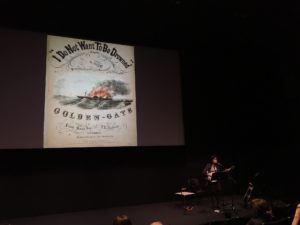Assembling through Music
Laura Belik on the Arts + Design Mondays @ BAMPFA | Public (Re)Assembly talk series
Hit Parade: Musical Archives and Public Knowledge with Josh Kun with Thao Nguyen, November 20, 2017
 Assembling through music happens all the time, but often we fail to notice how powerful this can be. Writer, curator and professor Josh Kun make this statement evident through his work “Hit Parade: Live in San Francisco”, that combines research, performance and curatorial works while discussing topics of gentrification in the Bay Area.
Assembling through music happens all the time, but often we fail to notice how powerful this can be. Writer, curator and professor Josh Kun make this statement evident through his work “Hit Parade: Live in San Francisco”, that combines research, performance and curatorial works while discussing topics of gentrification in the Bay Area.
Kun points out that Dj’s, for example, need to learn how to listen, reiterating how sensitive the act of playing for the others is. He explains how one has to know the moment, understand how to respect and to sustain sounds, while keeping them alive at the same time. Sound, thus, is a way to start a conversation, and most importantly, to learn how to listen. “Music is about making it audible. It is a demonstration of a collective presence” Kun points out, understanding music as a way of assembly and a political act. He also reminds us that being together (either playing or listening) is not necessarily about being in a consensus with one another, but is about the experience of sharing. These premises are made clear through Kun’s project
“Hit Parade”, started with Kun looking at the SF Public Library music library’s sheet music collection catalogued with call numbers that begin with “HP,” or “Hit Parade”. Kun’s archival research was driven by questioning who the people were that didn’t make it to the top of the charts, and were forgotten. Although this clearly seems to be a question related to music history, the interesting turnover is how Kun expands this conversation to a matter of gentrification in the city, thus presenting his motto with a beat: “Who has the hit, and who gets hit?”
“Hit Parade”. Digging through the archives of the SF Public Library, Kun’s research recognizes the changes that have been happening around San Francisco throughout the years. Gentrification can also be seen through music. Choosing sheet music that is in direct conversation with an event or iconic moment for its population, Kun invites a group of musicians to interpret the music as a collective. None of the musicians know each other previously, nor could they prepare beforehand for the performance, which happens live in front of an audience. By working as a kind of an open rehearsal, where people have to deal with each other in a public space, and ultimately, get to a consensus, Kun explores the connections this experience has as a public and collective way of thinking about assembly. Rehearsal is a method, a mode of dialogue. Kun’s goal with this experience is less about the finished product, but about the process, figuring out “how to assemble”.
Digging through the archives of the SF Public Library, Kun’s research recognizes the changes that have been happening around San Francisco throughout the years. Gentrification can also be seen through music. Choosing sheet music that is in direct conversation with an event or iconic moment for its population, Kun invites a group of musicians to interpret the music as a collective. None of the musicians know each other previously, nor could they prepare beforehand for the performance, which happens live in front of an audience. By working as a kind of an open rehearsal, where people have to deal with each other in a public space, and ultimately, get to a consensus, Kun explores the connections this experience has as a public and collective way of thinking about assembly. Rehearsal is a method, a mode of dialogue. Kun’s goal with this experience is less about the finished product, but about the process, figuring out “how to assemble”.
Assembly as music has the power of resonating with people. Besides his archival work, Kun’s research is also based in collecting oral histories of the ones who live in those neighborhoods facing rapid change. “People’s voices give voice to the city”. Music and sound, once again, are as much about being heard as to learn how to listen. “But music is the rehearsal, and not the change itself”, Kun reminds us. There is much to be done still. The lecture ended with a moving presentation by the singer and songwriter Thao Nguyen, that was also involved with Kun’s project.
Laura Belik (PhD Student, Architecture) reviewed the November 20, 2017 talk, Hit Parade: Musical Archives and Public Knowledge, the eleventh lecture in the Fall 2017 Arts + Design Mondays @ BAMPFA series. To learn more about the series, see below:
What is the role of public assembly in our current moment? And to what degree are new models necessary to respond artistically and technologically to our political climate? After a highly successful launch of Arts + Design Mondays @ BAMPFA in Spring 2017, Berkeley Arts + Design is pleased to present a new suite of exciting lectures that explore the theme of “public (re) assembly” from a variety of perspectives. The word assembly carries a range of associations. It challenges us to think about the democratic right to assemble; it recalls the artistic history of assemblage. It provokes us to imagine new systems of arrangement that respond to a digital age. It asks to consider how UC Berkeley might re-imagine the “school assembly” as a site of social transformation.
Learn more here.
